 | Asheville business & community directory |
|
This is an archived page that may contain outdated or incorrect information. Please visit www.Asheville.com for the latest news, events, and more.
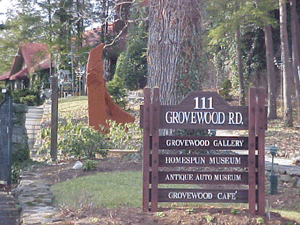 Biltmore Industries, for many years an exceptional outlet for traditional mountain arts and crafts and the one-time beneficiary of George and Edith Vanderbilt's generosity, is a long-running example of Asheville's propensity toward fostering local mountain industry. The following article, posted with the permission of local author, historian, and antiques authority Bruce E. Johnson, provides an in-depth look at Biltmore Industries and the impact it had on local artisans and crafts people throughout the 20th century.
Biltmore Industries, for many years an exceptional outlet for traditional mountain arts and crafts and the one-time beneficiary of George and Edith Vanderbilt's generosity, is a long-running example of Asheville's propensity toward fostering local mountain industry. The following article, posted with the permission of local author, historian, and antiques authority Bruce E. Johnson, provides an in-depth look at Biltmore Industries and the impact it had on local artisans and crafts people throughout the 20th century. A Brief History of Biltmore Industries In the years shortly after the completion of the Biltmore House in 1895, George and Edith Vanderbilt spent hours exploring the surrounding Blue Ridge Mountains, buying for their Northern friends homespun fabrics from the women who lived and worked in mountainside cabins. Their interest in the people of western North Carolina coincided with the arrival in Asheville in 1901 of two recent graduates of the Moody Bible Institute - Eleanor Park Vance (1869-1954) and Charlotte Louise Yale (1870-1958).
While many crafts were taught in those early years, the hand weaving of fine cloth, woodworking and woodcarving proved the most popular and practical. Edith Vanderbilt arranged for Yale and Vance to travel to Scotland to learn even more about looms and the art of weaving. George Arthur, who was among the original group who first met in Vance and Yale's small cottage, eventually became the woodshop foreman and a nationally recognized craftsman. Under the leadership of Yale and Vance, and with the benevolent guidance of Edith Vanderbilt, Biltmore Estate Industries soon established a reputation for quality craftsmanship across the country.
Without the time, experience or money to expand and direct Biltmore Estate Industries, Edith Vanderbilt elected to sell Biltmore Estate Industries to Fred Seely, the son-in-law of Edwin W. Grove. Seely had supervised the construction and furnishing of the Grove Park Inn in 1913 and since 1914, leased the 150-room hotel from Grove and managed it himself.
At the time, Seely had 10 years remaining on his lease for the Grove Park Inn, but control of the hotel remained in the firm grip of his father-in-law. Looking for additional means of enticing buyers to north Asheville, Grove agreed to lease Fred Seely a parcel of land immediately north of the inn for the new location of Biltmore Industries. The first of six buildings was completed in 1917 (see top photo). Designed by Fred Seely to complement the Grove Park Inn, the rough-stucco exteriors and gently-rounded rooflines are reminiscent of English country cottages tucked amid the tall Carolina pines on Sunset Mountain. Inside, each building hummed with activity. Under Seely's direction, the woodworkers began constructing additional looms for the weavers until, by 1920, a total of 45 looms were in steady operation, producing bolts of some of the highest quality homespun fabric in the country (Homespun cottage pictured below).
Fred Seely's death in 1942 was mourned by area residents, for few had done more than he to promote the scenic wonders of the Blue Ridge Mountains and Asheville. His youngest son managed Biltmore Industries for a few years, but as demand for homespun dwindled, the business and the buildings began to deteriorate. In 1953, Asheville businessman Harry Blomberg purchased Biltmore Industries, providing the leadership and resources necessary to keep the looms in operation for 30 additional years. Upon his death in 1991, ownership of Biltmore Industries transferred to Blomberg's daughters, Barbara Blomberg and Marilyn Patton, and his son-in-law, Buddy Patton, who renovated the grounds and buildings.
Grovewood Gallery is managed by Sherry Masters and Vanessa Osborne, who, with their staff, represent more than 400 artisans from around the country. The original grounds also feature the Estes-Winn Memorial Automobile Museum (see picture above), the North Carolina Homespun Museum and the Grovewood Caf�, all of which display historic photographs and memorabilia from the early days of Biltmore Industries.
For more information on Biltmore Industries or on a wide variety of topics relating to the history of western North Carolina, Robert S. Brunk's "May We All Remember Well," Volume I or Volume II, is an excellent and entertaining source.
|

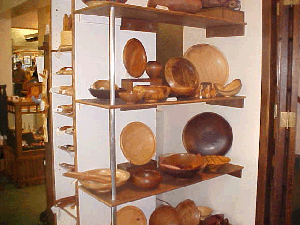 An accomplished woodcarver, Eleanor Vance began teaching the young boys who lived in Biltmore Village near Vanderbilt's estate how to carve wooden bowls and picture frames. By the end of 1901, Vance and Yale had established the Boys' Club of All Souls Church, which soon was brought to the attention of Mr. and Mrs. Vanderbilt. In 1905, with the financial support of the Vanderbilt's, Eleanor Vance and Charlotte Yale formed what was to be known as the Biltmore Estate Industries.
An accomplished woodcarver, Eleanor Vance began teaching the young boys who lived in Biltmore Village near Vanderbilt's estate how to carve wooden bowls and picture frames. By the end of 1901, Vance and Yale had established the Boys' Club of All Souls Church, which soon was brought to the attention of Mr. and Mrs. Vanderbilt. In 1905, with the financial support of the Vanderbilt's, Eleanor Vance and Charlotte Yale formed what was to be known as the Biltmore Estate Industries.  By 1916, the eight looms of Biltmore Estate Industries could not meet the demand for their homespun cloth; their hand-carved walnut and mahogany bowls, candlesticks, bookends and furniture sold briskly in their shop in Biltmore Village. The need for additional space was only partially relieved by moving the woodworkers into another building in Biltmore Village. But at a time when the Biltmore Estate Industries needed additional leadership and business experience, tragedy struck. In 1914, the 52-year-old George Vanderbilt died from complications related to a recent surgery. Edith Vanderbilt became solely responsible for the sprawling Biltmore Estate and a single parent for their 14-year-old daughter Cornelia.
By 1916, the eight looms of Biltmore Estate Industries could not meet the demand for their homespun cloth; their hand-carved walnut and mahogany bowls, candlesticks, bookends and furniture sold briskly in their shop in Biltmore Village. The need for additional space was only partially relieved by moving the woodworkers into another building in Biltmore Village. But at a time when the Biltmore Estate Industries needed additional leadership and business experience, tragedy struck. In 1914, the 52-year-old George Vanderbilt died from complications related to a recent surgery. Edith Vanderbilt became solely responsible for the sprawling Biltmore Estate and a single parent for their 14-year-old daughter Cornelia.
 Only after assuring Edith Vanderbilt that he would "continue its educational features and develop the arts as it was commercial" did she consent to sell Biltmore Estate Industries to Fred Seely in April 1917. Crucial to their agreement was Seely's promise to erect buildings for the woodcarvers and weavers adjacent to the Grove Park Inn. The change of ownership and move from Biltmore Village was reflected in the name. Beginning in 1917, it became Biltmore Industries. Locally, it was also called the Homespun Shops.
Only after assuring Edith Vanderbilt that he would "continue its educational features and develop the arts as it was commercial" did she consent to sell Biltmore Estate Industries to Fred Seely in April 1917. Crucial to their agreement was Seely's promise to erect buildings for the woodcarvers and weavers adjacent to the Grove Park Inn. The change of ownership and move from Biltmore Village was reflected in the name. Beginning in 1917, it became Biltmore Industries. Locally, it was also called the Homespun Shops. 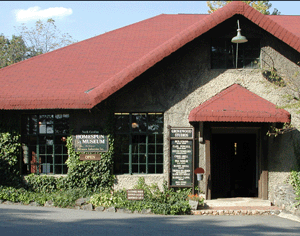 Although Seely established the woodworkers in their own building on the grounds, it soon became apparent that he had more of a personal and financial interest in the weaving operation. George Arthur resigned soon after Seely took control of Biltmore Industries and later started his own woodworking business, The Artisans Shop. The number of woodworkers at Biltmore Industries gradually declined until by the mid-1930s, their output was a small fraction of what it had been earlier.
Although Seely established the woodworkers in their own building on the grounds, it soon became apparent that he had more of a personal and financial interest in the weaving operation. George Arthur resigned soon after Seely took control of Biltmore Industries and later started his own woodworking business, The Artisans Shop. The number of woodworkers at Biltmore Industries gradually declined until by the mid-1930s, their output was a small fraction of what it had been earlier. 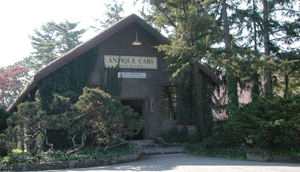 In 1992, Biltmore Industries came to life again with the opening of Grovewood Gallery. Each of the original six buildings has since been painstakingly stabilized and renovated by Harry Blomberg's family, providing two floors of gallery space for Grovewood Gallery, several studios for craftspeople, and the Grovewood Caf�. The grounds have been restored as well, with winding stone walkways, outdoor seating and dining areas, and an array of annuals and perennials.
In 1992, Biltmore Industries came to life again with the opening of Grovewood Gallery. Each of the original six buildings has since been painstakingly stabilized and renovated by Harry Blomberg's family, providing two floors of gallery space for Grovewood Gallery, several studios for craftspeople, and the Grovewood Caf�. The grounds have been restored as well, with winding stone walkways, outdoor seating and dining areas, and an array of annuals and perennials. 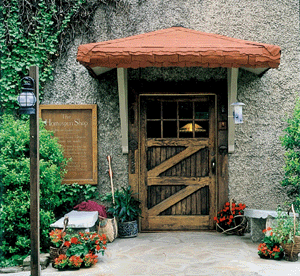 The charming and historic Grovewood Gallery (see bottom photo) is located at 111 Grovewood Road in north Asheville, immediately next to and just down the hill from the Grove Park Inn (290 Macon Avenue). Grovewood Gallery may be reached by phone at 828-253-7651 or on the Internet at www.grovewood.com. Grovewood Caf� is a great option for lunch or dinner; they can be reached at 828-258-8956.
The charming and historic Grovewood Gallery (see bottom photo) is located at 111 Grovewood Road in north Asheville, immediately next to and just down the hill from the Grove Park Inn (290 Macon Avenue). Grovewood Gallery may be reached by phone at 828-253-7651 or on the Internet at www.grovewood.com. Grovewood Caf� is a great option for lunch or dinner; they can be reached at 828-258-8956.